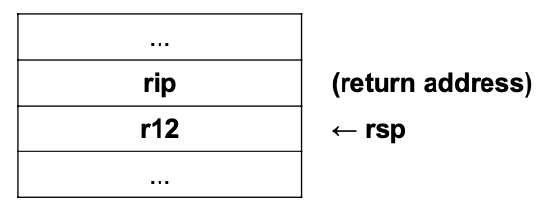12.13: Example, Statistical Function 1 (leaf)
- Page ID
- 58053
This simple example will demonstrate calling a simple void function to find the sum and average of an array of numbers. The High-Level Language (HLL) call for C/C++ is as follows:
stats1(arr, len, sum, ave);
As per the C/C++ convention, the array, arr, is call-by-reference and the length, len, is call-by-value. The arguments for sum and ave are both call-by-reference (since there are no values as yet). For this example, the array arr, sum, and ave variables are all signed double-word integers. Of course, in context, the len must be unsigned.
12.9.1 Caller
In this case, there are 4 arguments, and all arguments are passed in registers in accordance with the standard calling convention. The assembly language code in the calling routine for the call to the stats function would be as follows:
; stats1(arr, len, sum, ave);
mov rcx, ave ; 4th arg, addr of ave
mov rdx, sum ; 3rd arg, addr of sum
mov esi, dword [len] ; 2nd arg, value of len
mov rdi, arr ; 1st arg, addr of arr
call stats1
There is no specific required order for setting the argument registers. This example sets them in reverse order in preparation for the next, extended example.
Note, the setting of the esi register also sets the upper-order double-word to zero, thus ensuring the rsi register is set appropriately for this specific usage since length is unsigned.
No return value is provided by this void routine. If the function was a value returning function, the value returned would be in the A register (of appropriate size).
Callee
The function being called, the callee, must perform the prologue and epilogue operations (as specified by the standard calling convention) before and after the code to perform the function goal. For this example, the function must perform the summation of values in the array, compute the integer average, return the sum and average values.
The following code implements the stats1 example.
; Simple example function to find and return
; the sum and average of an array.
; HLL call:
; stats1(arr, len, sum, ave);
; -----
; Arguments:
; arr, address – rdi
; len, dword value – esi
; sum, address – rdx
; ave, address - rcx
global stats1
stats1:
push r12 ; prologue
mov r12, 0 ; counter/index
mov rax, 0 ; running sum
sumLoop:
add eax, dword [rdi+r12*4] ; sum += arr[i]
inc r12
cmp r12, rsi
jl sumLoop
mov dword [rdx], eax ; return sum
cdq
idiv esi ; compute average
mov dword [rcx], eax ; return ave
pop r12 ; epilogue
ret
The choice of the r12 register is arbitrary, however a 'saved register' was selected. The call frame for this function would be as follows:

The minimal use of the stack helps reduce the function call run-time overhead.

